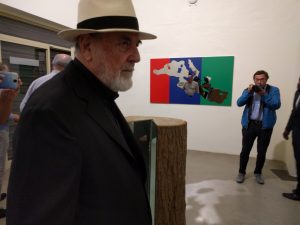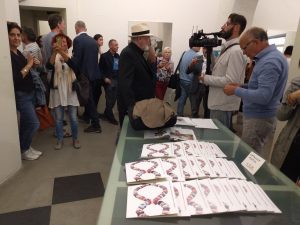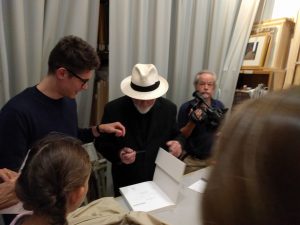Michelangelo Pistoletto was back in Pistoia, and it was definitely an intense come back: the artist from Biella received a warm welcome by the institutions and, above all, the citizens. The relationship between Pistoletto and the Tuscan city is very strong, it was in fact in Pistoia that, in 1994, the artist first presented his “Progetto Arte” manifesto. The events that saw him protagonist and on which we will focus – the conference at the Palazzo dei Vescovi, the “journey” of the Third Paradise and the opening of the exhibition – were extremely popular. The success was not only given by the strong presence of the citizens of Pistoia, but also by their variety and involvement: different generations listened to and met Pistoletto with different shades of enthusiasm, but with the same artistic ardour. The context was the ideal one to host the meetings with the artist: Piazza del Duomo, the centre of the city, revealed itself to be the perfect historic backdrop for the events in programme. As anticipated in one of our previous articles, the day started at the Palazzo dei Vescovi, where, in its Sinodal Hall, Pistoletto’s new book – or better, his latest political manifesto – “Ominiteism and Demopraxy” was presented.
The presentation started at 12 o’clock, in a room crammed with people. The artist from Biella introduced the book together with Pistoia’s ambassadress Chiara Belliti, who collaborated in its editing. Different topics were brought up, such as art and the Third Paradise, politics and demopraxy, religion and ominiteism. “The first part of the book talks about ominiteism,” explained Pistoletto, “born from the idea that every individual must be able to be autonomous and assume responsibility for their actions, factors often conferred to superior beings. These elements allow us to connect with society and find a balance. Ominiteism is therefore the emancipation from supernatural entities, meaning that all we have projected in a divine “verticularness” must assume “horizontalness” among us.


The artist then talked about the sign-symbol of the Third Paradise: “The Third Paradise connects nature and artifice, it is the balance between two opposite elements which join to create a condition that didn’t exist before. Here’s an example: oxygen and hydrogen together make water. Or a man and a woman, who can create a child. This is trinamics, the dynamics of number three; the combination of two elements generating a third, distinct and original, always representing a birth. Adding one to one, you therefore get three, not two.” The last part of the book is centred around the shift from democracy to demopraxy. In his speech, Pistoletto highlighted the failure of democracy, stressing how people’s power (from the Greek demos, “people”, and kratos, “power”) is utopistic, considering that the representatives of the people are too distant from their needs. He has therefore identified demopraxy as the solution (the term, created by Cittadellarte’s director Paolo Naldini, focuses on praxis, meaning “action”, in the sense of “doing”), concentrating on people’s actions as a way to get social freedom and balance. Chiara Belliti then read to the audience the last chapter of the book, on the very topic of demopraxy.
After the conference, the artist moved to the room of the Palazzo displaying the Arazzo Millefiori, where there was a Third Paradise, a collective creation made of recycled material by women from the social cooperative Manusa. The photographers took all the customary pictures of Pistoletto with the participants on the background of his works.


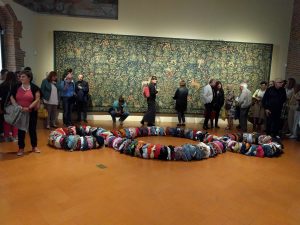
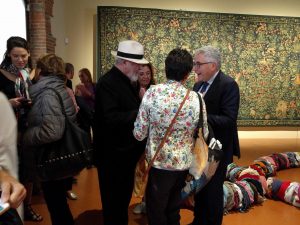
In the afternoon, the “journey” of this Third Paradise started: the work was carried from the Palazzo dei Vescovi along the city streets to the Vannucci gallery. The journey itself was a collective performance: the big dimension work, carried by a few volunteers, attracted and intrigued a lot of people who ended up following or helping carry the Third Paradise. Michelangelo Pistoletto led the participants to the art gallery.
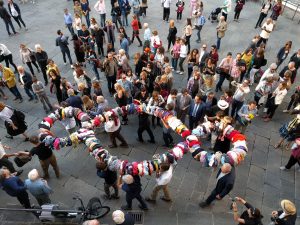
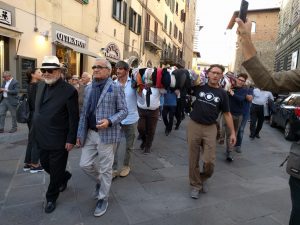


The arrival of the work at the artistic location marked the opening of the exhibition “Pistoia 30th September 2017 – Michelangelo Pistoletto present”. Why this title? “The title has a double use,” says the catalogue, “it gives the exhibition a name and sense, and recalls the thread linking Pistoletto to our city. A thread starting from very far away and never lost. As far as our gallery is concerned, Pistoletto has always been present, even if it the first time we exhibit his works. The artist has always preferred the voices of the community to the intimacy of his studio, and has looked into the mirror meaning to find himself but finding something else. Art and/is life”.
A large public visited the exhibition and met Pistoletto, who was happy to talk with the attendees and be photographed.
After 20 years nothing has changed: the artistic relationship between Pistoletto and Pistoia is still the same, in fact actually stronger after Saturday’s events.
